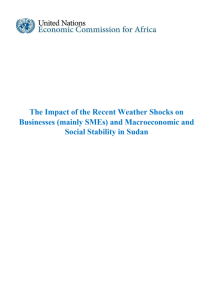In 2020, the government of Sudan was affected by the worst flooding in over three decades after months of rains across Central and North-Easter Africa. Since the start of the rainy season in July, large rainfall surpluses had been recorded throughout the Greater Horn of Africa. Heavy rains in the upstream catchments of the Blue Nile (Ethiopia) and the White Nile (South Sudan) resulted in a dramatic increase of Nile water levels. In total, the floods affected all 18 States in Sudan. Areas along the Blue and White Nile as well as the capital Khartoum were heavily flooded, while also non-Nile States, in particular North Darfur, were impacted by heavy local rains and flash floods. The flood devastated the biophysical and built infrastructure with ripple effects on businesses mainly SMES, and macroeconomic and social stability. This prompted government to seek out additional support from donors and development partners, including from UNECA, to devise effective plans and actions for both reconstruction and greener recovery. To respond to that demand, UNECA has coordinated an assessment of the effects of that flood on the businesses and macroeconomic and social effects, which produced an insight that informed the proposed recommendations to support development of national reconstruction and green recovery plans.
Share this:
Release Date:
3 August, 2024
© United Nations Economic Commission for Africa

